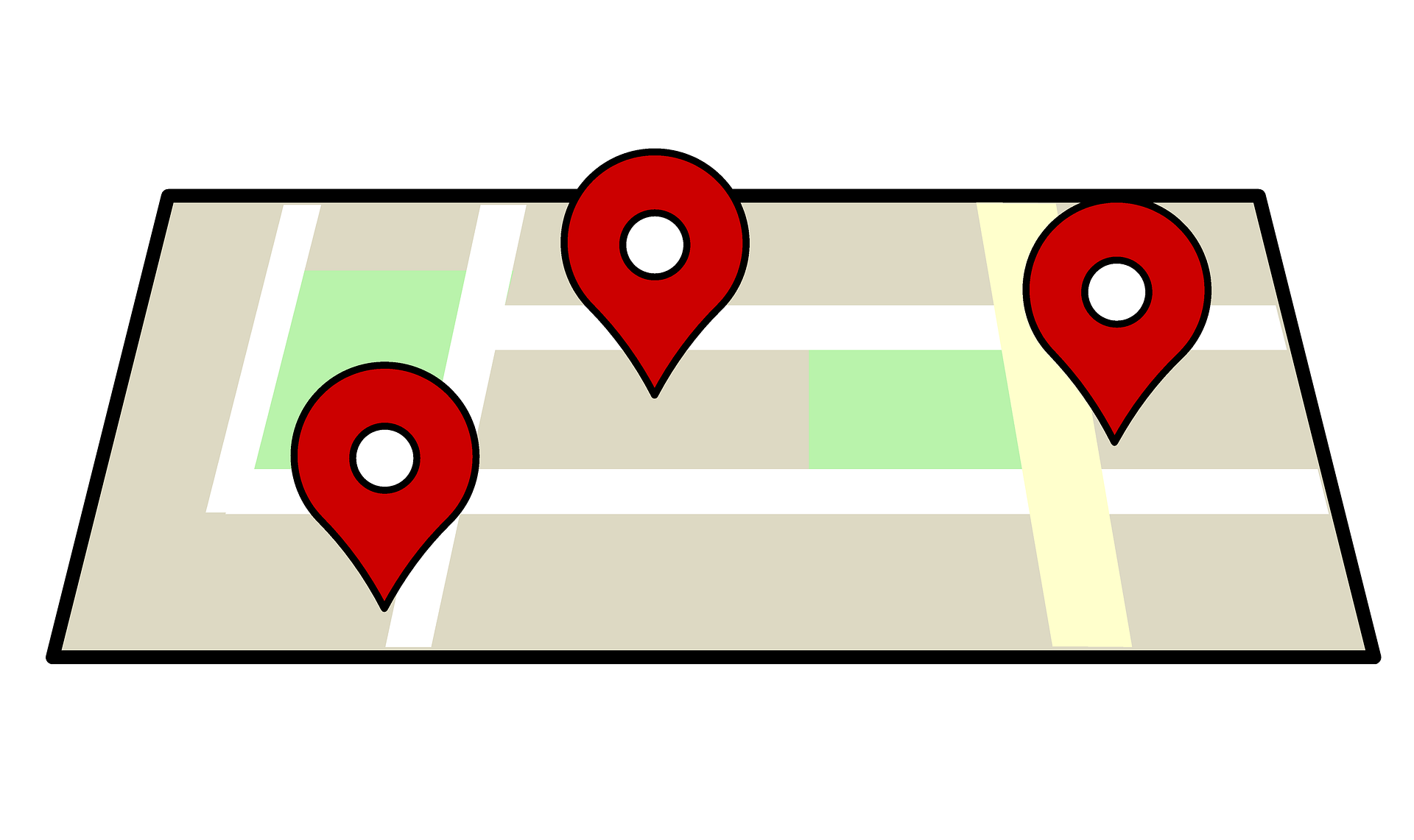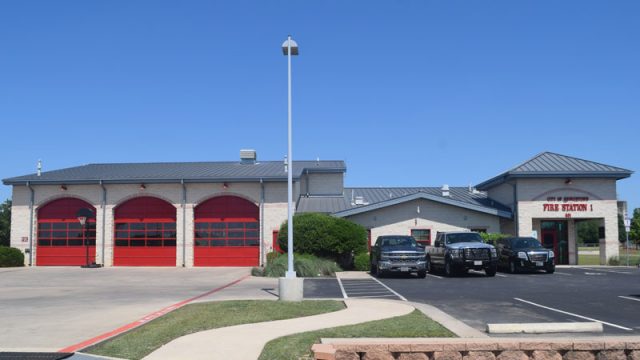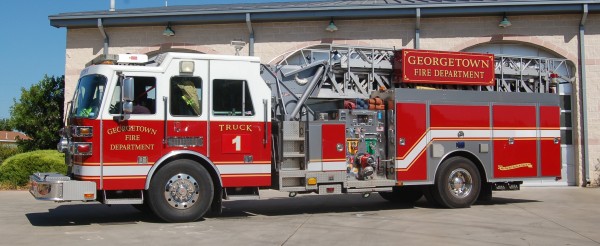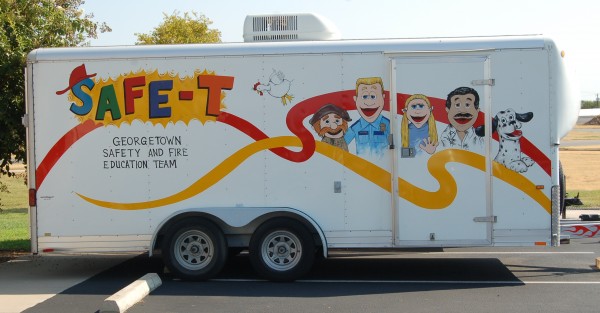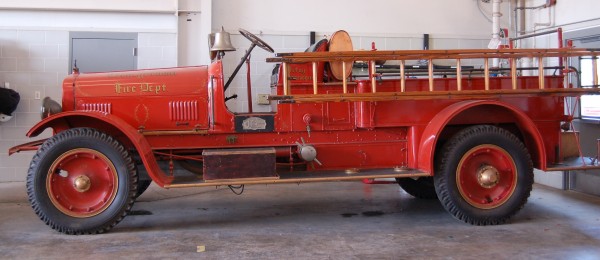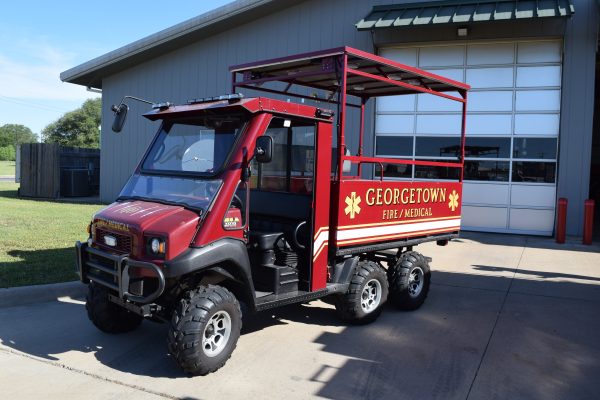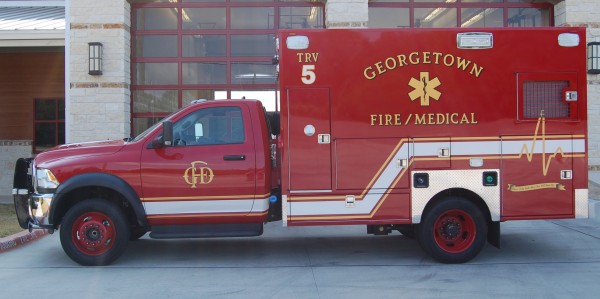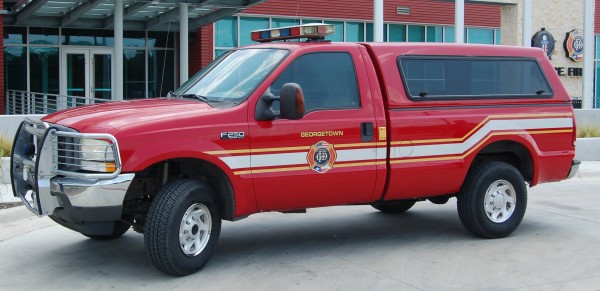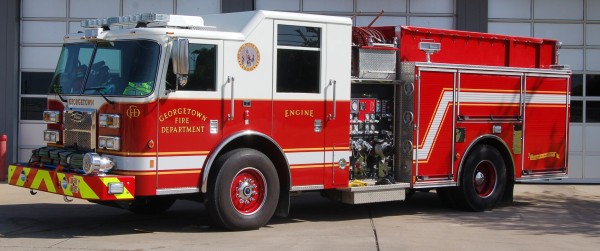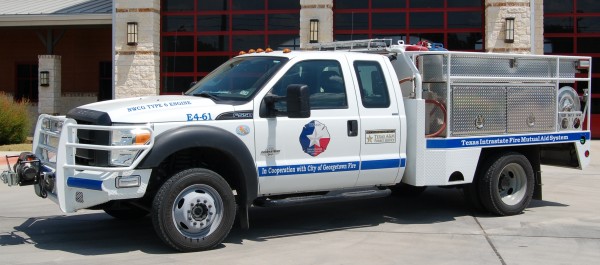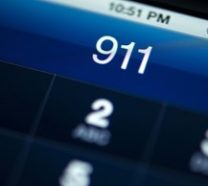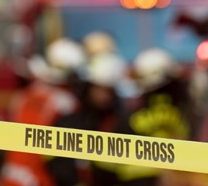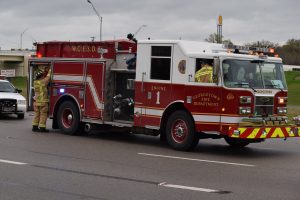Fire Station 1
Year Constructed: 2006
Located at 301 Industrial Ave, Georgetown, TX 78626
Serves the Southern districts
Apparatus
Medic 1 – 2015 Frazer Dodge 4500 Ambulance
Engine 1 – 2011 Pierce Engine
Truck 1 – 2008 Sutphen 100′ Aerial Platform Ladder Truck
Brush Truck 1 – 1993 International Type 4 Engine
Swift Water Boat 1 – 2007 Achilles FRB124
Rescue 1 – 1994 SVI International Rescue
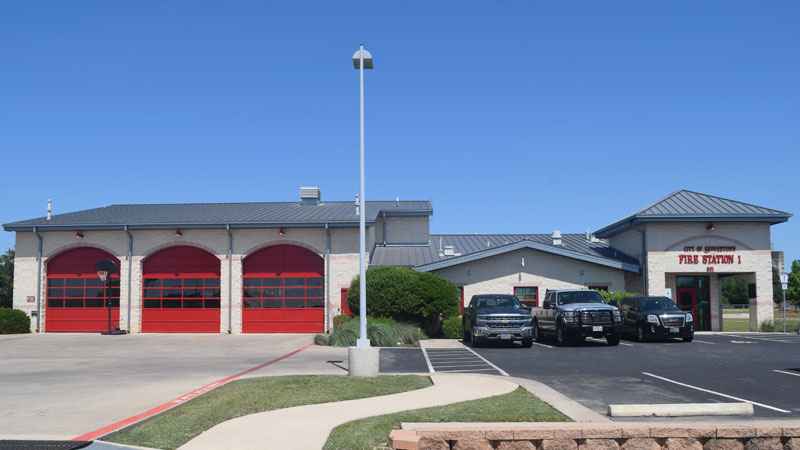

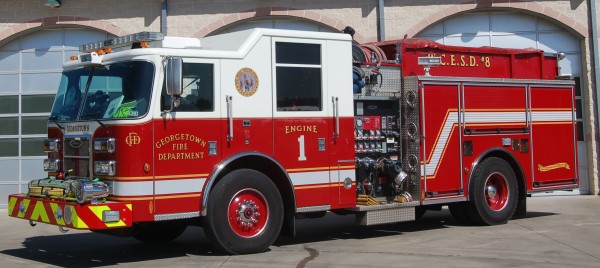

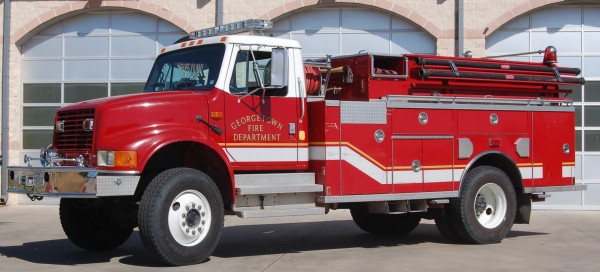
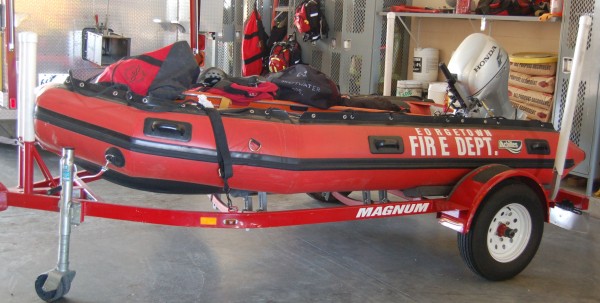
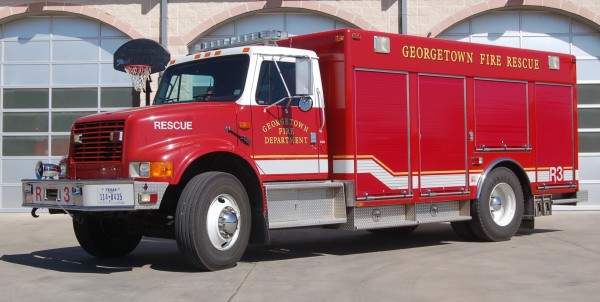
Fire Station 2
Year Constructed: 2013
Located at 1603 Williams Drive, Georgetown, TX 78628
Serves the Central fire district
Apparatus
Medic 2 – 2014 Frazer Dodge 4500 Ambulance
Engine 2 – 2013 Pierce Engine (part of Williamson County Haz-Mat response)
Battalion 1 – 2013 Ford F350 Command Unit
Haz-Mat 2 – Dodge F350 and Wells Fargo Trailer
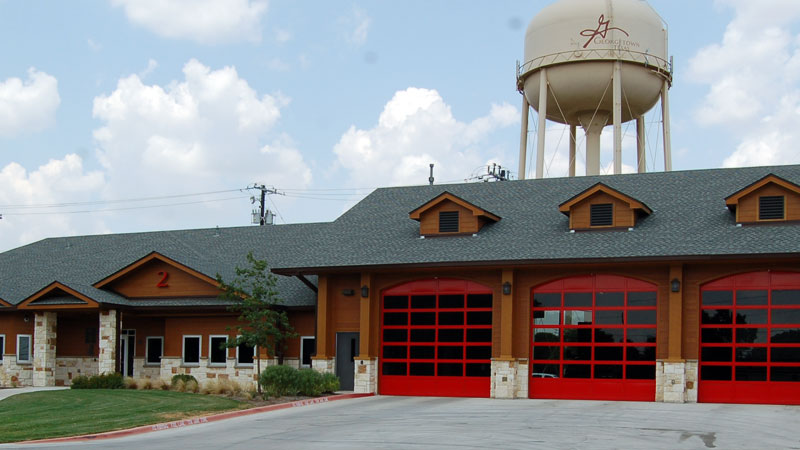
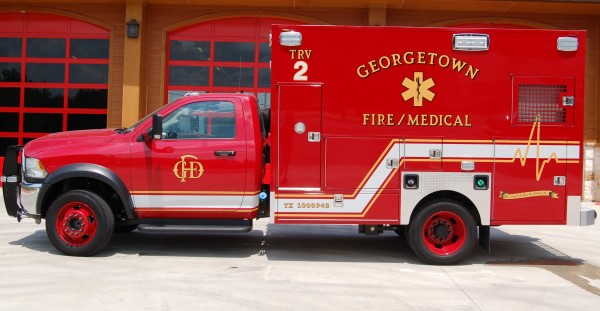
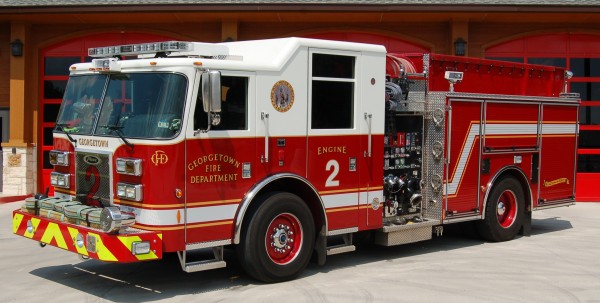
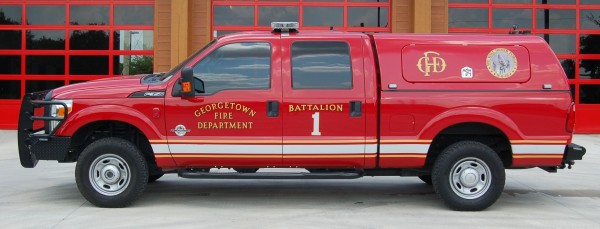
Fire Station 3
Year Constructed: 1998
Located at 5 Texas Drive, Georgetown, TX 78633
Serves Sun City and the Northwest district
Apparatus
Medic 3 – 2014 Frazer Dodge 4500 Ambulance
Engine 3 – 2012 Pierce Engine
Brush Truck 3 – 1993 Type IV International Engine

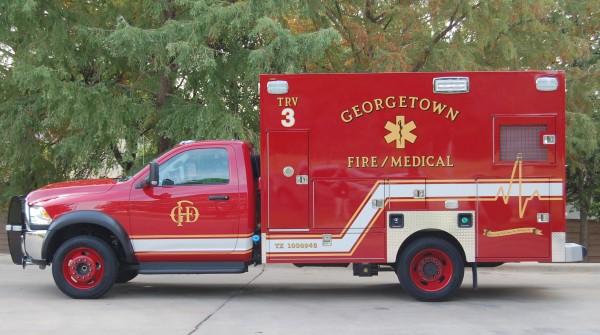
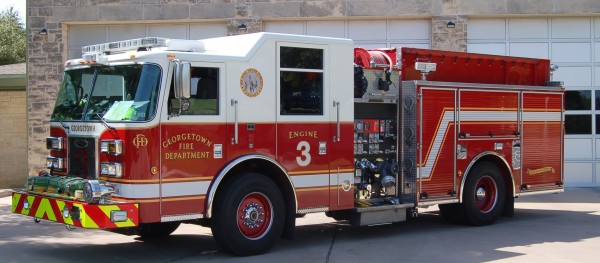
Fire Station 4
Year Built: 2001
Located at 4200 Airport Road, Georgetown, TX 78628
Serves the Georgetown Airport and the North Central Area of the fire district
Apparatus
Engine 4 – 2009 Pierce Engine
Truck 51 – 2004 Sutphen 75′ Aerial Ladder
Georgetown Safety and Fire Education Team SAFE-T Trailer
Betsy – 1922 Seagrave Triple combination pumper
FireMedic 1 – ATV – Kawasaki Mule 4010
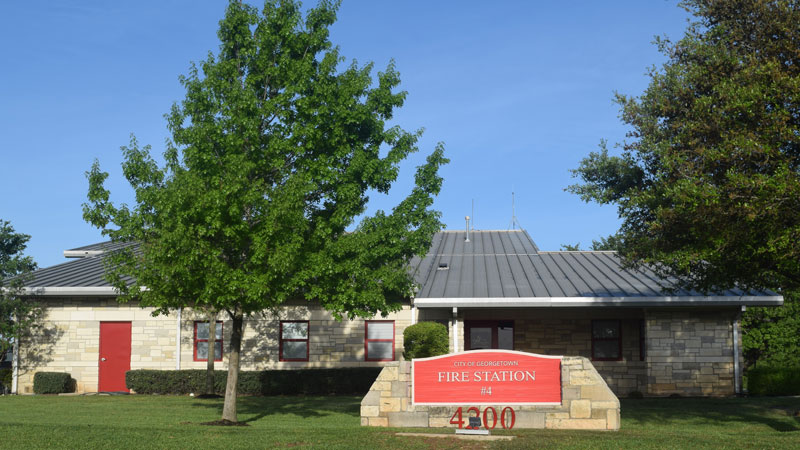
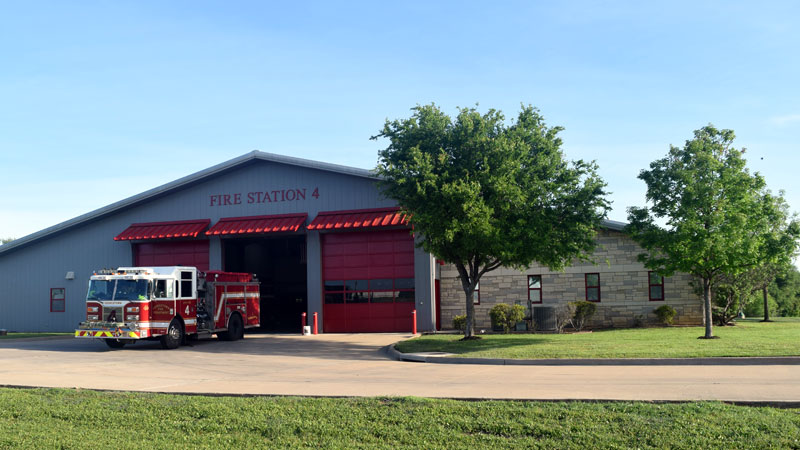
Fire Station 5
Year Constructed: 2012
Located at 3600 D.B. Wood Rd, Georgetown, TX 78628
Serves Lake Georgetown and the Northwest area of the fire district
Station 5 also houses the Training Division.
Apparatus
Medic 5 -2015 Dodge Frazer Ambulance
Engine 5 – 2012 Pierce EnginE
Truck 5 – 2006 Sutphen 75′ Aerial Ladder Truck
Rescue 5 – 1995 International Super-Vac Rescue
Engine 51 – 2014 Pierce Contender Engine
Engine 4-61 – 2010 TIFMAS Type 6 Engine
Dive 5 – 2010 Chevy Cargo Truck
Dive Boat 5 – 2012 Rescue-One Dive Rescue Boat
Swift Water Boat 5 – 2007 Achilles FRB124
Bike Team – 1991 Wells Fargo Trailer
FTO1 – 2004 Ford F250 Safety/Training Officer
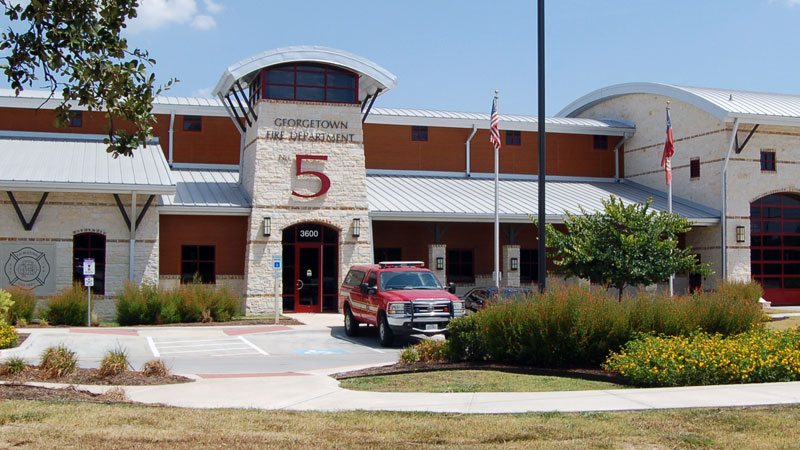
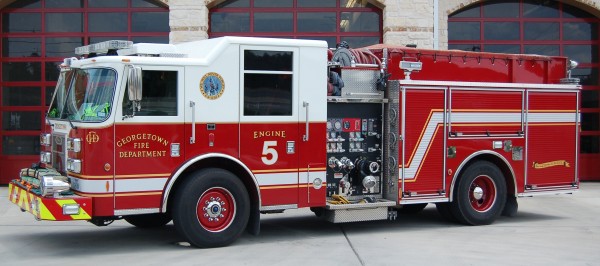
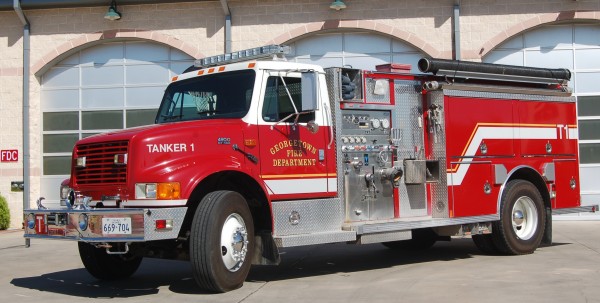
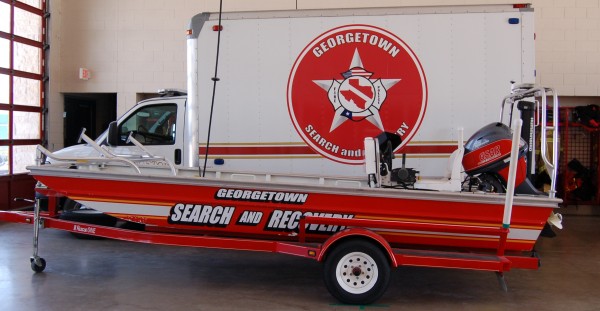
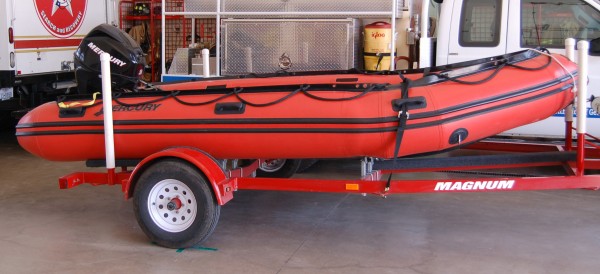
Severe Weather Information
 Severe Weather Season is Here! Preparation is Our Best Defense! Severe weather season can bring frightening storms, incredible damage and change lives in the blink of an eye. The best way to meet violent Texas weather is to be prepared.
Severe Weather Season is Here! Preparation is Our Best Defense! Severe weather season can bring frightening storms, incredible damage and change lives in the blink of an eye. The best way to meet violent Texas weather is to be prepared.
KnoWhat2Do has a number of steps you can take to help each member of the family know what to do when storms are coming.Knowing your hazards is just one component of preparedness- the next step is to ACT! Make sure each member of the family knows how to use the following resources:
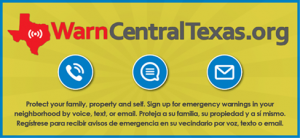 Emergency Notification System through WarnCentralTexas
Emergency Notification System through WarnCentralTexas
The Capital Area Council of Governments uses a regional notification system (RNS), WarnCentralTexas.org, as a crucial public-safety tool. The Web-based tool is available to users throughout the CAPCOG region to alert the public to emergency and non-emergency situations. It’s an effective tool for notifying a relatively large number of people in a short period of time. Messages may include content such as incident-specific information, recommended protective actions or response directives. They can be delivered to various devices that accept voice, email or SMS text content and to alpha or numeric pagers. The message sender identifies recipients, develops the message and determines which types of devices receive the message. Regional partners that use RNS can send voice messages to landline phones using CAPCOG’s 9-1-1 database. However, residents and visitors to the CAPCOG region must register their cellphone numbers and email addresses to receive notifications on mobile devices or computers.
NOAA All Hazards Weather Radio (NWR)
Listen for emergency information.
The NOAA Weather Radio All Hazards, or NWR, is a nationwide network of radio stations broadcasting forecasts, warnings, and emergency information 24 hours a day. It is a comprehensive weather and emergency information service available to the public. All-hazards messages include weather events, technological incidents like chemical spills, AMBER alerts, and national emergencies. NWR also broadcasts EAS notices.
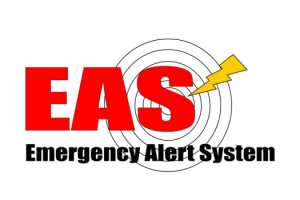 The FEMA Emergency Alert System (EAS) Tune into your radio for instructions.
The FEMA Emergency Alert System (EAS) Tune into your radio for instructions.
The Emergency Alert System (EAS) is used by alerting authorities to send warnings via broadcast, cable, satellite and wireline communications pathways. EAS participants, which consist of broadcast, cable, satellite and wireless providers, are the stewards of this important public service in close partnership with alerting officials at all levels of government. The EAS is also used when all other means of alerting the public are unavailable, providing an added layer of resiliency to the suite of available emergency communication tools. FEMA constantly works to improve the EAS is to better ensure seamless integration of CAP-based and emerging technologies.
Outdoor Warning System
Pay attention to sirens. Sirens may be used for all-hazard notification. When sirens are sounded, go indoors and tune in to local news and radio programs to understand the nature of the emergency.
TV Broadcasts Watch for emergency interruptions and tune into news stations.
If you live in a trailer or other housing susceptible to tornadoes or high winds, consider your evacuation plan.
- Plan places to meet within and outside of your immediate neighborhood.
- Keep a half tank of gas in your car at all times in case you need to evacuate.
- Familiarize yourself with alternate routes out of your area.
- If you don’t have a car, plan other means of transportation.
A tornado is one of nature’s most powerful and destructive forces.

- Prepare for a tornado by gathering emergency supplies including food, water, medications, batteries, flashlights, important documents, road maps, and a full tank of gasoline.
- When a tornado approaches, anyone in its path should take shelter indoors—preferably in a basement or an interior first-floor room or hallway.
- Avoid windows and seek additional protection by getting underneath large, solid pieces of furniture.
- Avoid automobiles and mobile homes, which provide almost no protection from tornadoes.
- Those caught outside should lie flat in a depression or on other low ground and wait for the storm to pass.
911 Tips
Do’s and Don’ts When Faced with Fire Emergencies
Calling 9-1-1 : What to Expect
Georgetown has an enhanced 9-1-1 system. This means that the 9-1-1 operator (referred to as the “dispatcher”) can identify through the system’s computer, the phone number and address of the calling party. This assists in timely dispatching of police or fire units to the emergency scene.
-
The caller should tell the dispatcher which type of emergency they are reporting (police, fire, or medical) or give a description of the problem, allowing the dispatcher to decide how to route the call.
-
Whenever a person calls 9-1-1, their message needs to be clear. The dispatcher will ask you a series of questions and verify the address. They also need to stay on the phone until the person in the 9-1-1 center has released them from the conversation.
-
The dispatcher will begin to dispatch emergency units immediately and the closest available fire engine or ladder truck will respond to the call.
-
All Georgetown firefighters receive medical training and are certified Emergency Medical Technicians (EMTs) or Paramedics.
-
Try to stay calm. State what kind of emergency it is — fire, car accident, trauma, etc. Then tell the dispatcher where the incident is.
-
Stay on the phone. The dispatcher may ask more questions or want you to stay on the line. Emergency units already have been dispatched even while you are talking with the dispatcher.
Children should be taught their home address and telephone number as soon as possible. The address and phone number of the caller’s location may only be displayed to the 9-1-1 dispatcher if calling from a landline. In the day and age of where mobile phones become the norm, this can make locations hard to verify.
Location
When the fire department responds to a given location, it may be delayed in arriving if the address is not clearly seen from the street.
Although it’s fairly easy to spot a column of smoke from a house fire, it’s difficult to see someone’s heart attack from the street. In a medical emergency, firefighters may waste critical time having to knock on several doors to try and find a correct address. Make sure your address is clearly visible from the street with numbers at least three or four inches in height and reflective.
This problem is compounded in large condominium and apartment complexes. Arriving at a correct address, the engine company finds a huge residential facility with many buildings in the complex. Make sure large identification lettering or numbering is mounted on the side of the building. This is as important as the street address. It would be even better if someone could be standing near the street to direct the fire units to the appropriate apartment.
When an emergency vehicle is heard and/or seen, drivers should carefully pull their vehicle to the right of the road and stop. If they are at an intersection, or stopped in traffic when they see lights or hear a siren, drivers should remain stopped and wait until the emergency vehicles have passed. Do not make quick or erratic maneuvers. The law is very specific; drivers must yield the right-of-way to an emergency vehicle. Drivers also should stay 500 feet behind emergency vehicles.
A crash involving an emergency vehicle delays help to those who need it. Firefighters are careful to avoid vehicle collisions by driving slowly when traveling against traffic, or coming to a complete stop at intersections. The cooperation of all vehicles on the roadway is required.
Arson
A mission of Fire Prevention is to provide fire investigation and law enforcement services to the citizens of Georgetown through complete and thorough investigations, evidence collection and professional expert testimony in court proceedings.
Fire Prevention is responsible for investigating suspicious fires and explosions throughout the city. Nationally, arson (and suspected arson) is the primary cause of property damage due to fire in the United States and the second leading cause of building fire deaths. To combat this serious problem, certified investigators respond to assist the public 24 hours a day, seven days a week. Arson investigators are sworn peace officers authorized to interview witnesses, collect evidence, make arrest and appear in court.
If you have information or questions concerning fire crimes, contact the Fire Marshal’s Office at 512 930-8416 or jason.fryer@georgetown.org.
The State of Texas Arson Hotline can be reached at 1-877-434-7345. If your information leads to the arrest of the person(s) responsible for an intentionally set fire, you may receive a reward of up to $1000.00.
Rank Structure
The rank structure is as follows (in ascending order): Probationary Firefighter, Firefighter, Driver Engineer, Lieutenant, Captain, Battalion Chief, Assistant Chief, and Fire Chief. Promotions to all rank below assistant chief are conducted through state civil service testing process.
Fire Department units are usually divided into a few basic categories.
Company(s) – This is the basic unit. This is made up of a single piece of apparatus and it’s crew. The company can be supervised by an officer. Usually a Lieutenant supervises an Engine Company or Rescue Company and a Captain supervises a Ladder/Truck Company. If the Captain is off duty for some reason, (vacation, illness, working in another capacity, etc.) the Lieutenant will often move up and take his place. He would be referred to as an “Acting Captain” for the day. If the Lieutenant is off duty for some reason, (vacation, illness, working in another capacity, etc.) the Driver Engineer would move up to “Acting Lieutenant.”
Battalion(s) – The city currently has one Battalion. This is usually made up of 4 to 5 stations and the companies that are quartered there. These companies and personnel are supervised by a Battalion Chief. There is a Battalion Chief (BC) assigned to each of the three shifts. Battalion Chiefs also are assigned to staff positions, such as Training & Safety.
You might want to think of it this way.
- Probationary Firefighter (PFF) – is an “at will” entry level position that is currently being trained and evaluated during their first 12 months of employment.
- Firefighter (FF) – is a basic worker that is responsible for hose line placement, fire suppression, operating rescue tools, search and rescue, etc. There is usually 1 – 2 in most companies. In the absence of the Driver Engineer, works as the “Acting DE” (Note: “Firefighter” is the generic term for all members of a fire department, but it is also a rank within the organization.)
- Driver Engineer (DE) – Also known as “Chauffeur”, “Apparatus Operator (AO)”, “Fire Equipment Operator” (FEO) and other terms. This is the person who drives the apparatus and operates the fire pump or aerial ladder. They are specialist who knows everything about that piece of apparatus. In the absence of the Lieutenant, the DE works as “Acting LT”.
- Lieutenant (LT) – This officer supervises daily operations, training, and emergency response of an Engine Company or Rescue Company and the personnel assigned to it. In the absence of the Captain, works as “Acting Capt”
- Captain (CAPT) – This officer supervises daily operations, training, and emergency response of a Ladder/Truck Company and the personnel assigned to it and the Fire Station. They may have one or more Lieutenants working at the station on an Engine Company or Rescue Company. This officer is often the initial commander at emergencies and can be called upon to fill in for the Battalion Chief during his or her absence. A Captain may also be over a special section or function. Examples are: Dispatch, Training, EMS etc.
- Battalion Chief (BC) – The Battalion Chief is really the person who insures that day to day operations are possible. Consider this: there are 168 hours in a week and the Fire Chief and Assistant Chief work 40 hours a week. For most of the time, the Battalion Chief is the highest ranking officer on duty. Before the oncoming shift starts and outgoing shift leaves, the Battalion Chief must make sure that there are enough people on duty. Does this sound easy? Imagine having 50 people who work for you. Each person has a very specific role and every role must be covered. You might have one or two extra people on some days, but what if too many people call in sick at the last minute? What do you do? Perhaps you can hire an overtime firefighter, who is not a paramedic, but you need a paramedic. Do you get on the phone and hope you can find a paramedic who can quickly come in? Do you move four people around so you can finally put that firefighter where you don’t need a paramedic and move the paramedic from his station to another station? This is just one job that a BC may face every day, and the shift hasn’t even started yet. Schedules have to be planned in advance. Vacations need to be scheduled and assignments need to be considered. If a firefighter gets injured or a vehicle has an accident, it is the Battalion Chief who makes the initial investigation report. The list of jobs and responsibilities can go on and on. Every detail of the battalion is handled, in some way, by the BC. Sometimes a decision is made to take an issue to a higher level, but that is rare. Besides the day to day logistical paperwork and time spent on the phone that takes up much of the chief’s time, there is the chaos of an emergency scene which requires a great deal of communication and information coordination.
- Assistant Chief – Manage, control, and direct activities of personnel assigned to the Operations Division. Manage the administrative and operational functions of the Department. Develop, implement, and administer programs and projects to ensure the continued quality of fire services and facilities through the effective use of resources. Provide professional and technical assistance to the Fire Chief and other department staff. Assist in preparing the Operating and Capital Improvement Budgets and oversees the planning and construction of future fire stations.
- Fire Chief – The executive head of the Fire Department and is directly responsible for proper and efficient operations. Supervise, regulate and manage the department and have control of all its personnel and activities, including fire safety education, fire protection, fire extinguishment, emergency medical service, administration, and to provide highly responsible and technical assistance to the City Manager.







